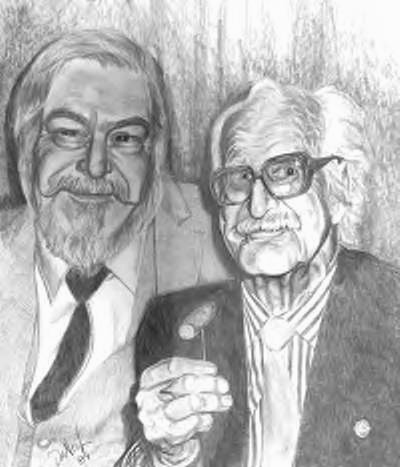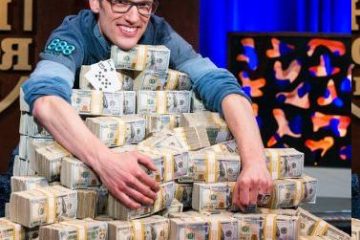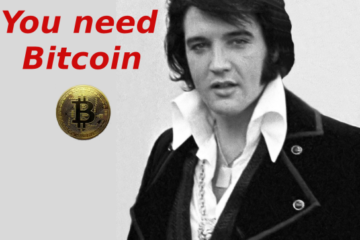Dai Vernon (pronounced alternatively as DIE or as DAY as in David) (June 11, 1894 – August 21, 1992), a.k.a. The Professor, was a Canadian magician.
His expert sleight of hand technique and extensive knowledge, particularly with card tricks and close-up magic, garnered him respect among fellow magicians.
His influence was considerable in the magic world of the 20th Century, and he was a mentor to numerous famous magicians. He lived out his last years at the Magic Castle, a nightclub in Hollywood, California.
Biography
Vernon was born in Ottawa as David Frederick Wingfield Verner. While performing, he often mentioned that he had learned his first trick from his father at age seven, adding wryly that he had “wasted the first 6 years” of his life. His father was a government worker and an amateur magician. Vernon studied mechanical engineering at the Royal Military College of Canada in Kingston, Ontario, but by World War I he had moved to New York City.
Vernon first fell in love with magic when he was seven years old after his father took him to see a magic show. The first real magic book he ever owned was an early edition of perhaps the most famous card book of them all, The Expert at the Card Table, by S. W. Erdnase. By the time he was 13 he had memorized the contents of the book. He also had a famous encounter with another up-and-coming young magician from his town, Cliff Green, who asked Vernon, “What kind of magic do you do?” Vernon responded by asking the boy to name a card. Upon pulling a pack of cards from his pocket, Vernon turned over the top card of the deck to reveal the named card and replied to the speechless Green “That’s the kind of magic I do. What kind of magic do you do?”
As a young man, Vernon moved to New York where, in the back room of Clyde Powers’ magic shop, he found favor among many of the great magicians of the era, including Dr. James William Elliott and Harry Kellar.
He began to use the first name “Dai” after a newspaper used the name in place of “David”; the paper actually was using the Welsh nickname for David. When Verner first moved to the United States, the male member of a popular ice-skating pair had the surname Vernon; Americans continually mistook Verner’s last name to be the same as the popular ice skater, and eventually the magician became fed up with correcting people and simply adopted “Vernon” as well.
Owing to his extraordinary knowledge of, and skill at, sleight of hand, Vernon has long been affectionately known as The Professor. Harry Houdini (who in his early years billed himself as “The King of Kards”) often boasted that if he saw a card trick performed three times in a row he would be able to figure it out. Vernon then showed Houdini a trick where he removed the top card of the deck and placed it second from the top, then turned over the top card to again reveal the original card. Houdini watched Vernon do the trick seven times, each time insisting that Vernon “do it again.” Finally, Houdini’s wife and Vernon’s friends said, “Face it, Houdini, you’re fooled.” For years afterward, Vernon used the title The Man Who Fooled Houdini in his advertisements.
Though respected by professional magicians nationwide due in part to publicity via the magazine The Sphinx, Vernon was essentially a gifted amateur until his 40s. Before the Magic Castle, Vernon never held a steady full-time job for more than a few months. He occasionally performed magic at nightclubs or on cruise ships to South America and back, and also toured the Philippines as an entertainer during WW2 with the United Service Organizations. His engineering degree was put to use as a sometime blueprint reader. However, Vernon’s main source of income was cutting custom silhouette portraits, a talent that paid 25 to 50 cents per silhouette for about two minutes work during the 1920s and ’30s. A few hours a week cutting silhouettes was generally enough to support his family and finance his sleight of hand hobby (compare his silhouette fee with the first US minimum wage of 25 cents per hour in 1938). Vernon spent most of his early life traveling all over the United States of America looking for card cheats, and anyone who might know anything about sleight-of-hand with cards. He was famously under-credited for much of the work published in Jean Hugard and Frederick Braue’s Expert Card Technique, though a later edition included an extra chapter which acknowledges Vernon’s contributions. In fact, a huge portion of the sleight-of-hand had been discovered by Vernon over years of searching.
Among magicians, he is credited with inventing or improving many standard close-up effects with cards, coins, and other small items. The “standard” Cups and balls routine is his, and his 6-ring “Symphony of the Rings” remains one of the most popular Chinese linking rings routines in use to this day.
Vernon spent the last thirty years of his life as Magician-in-Residence and star attraction at The Magic Castle in Los Angeles, California. There he mentored numerous well-known magicians including Ricky Jay, Persi Diaconis, Doug Henning, Larry Jennings, Bruce Cervon, Michael Ammar and John Carney.
Family
In 1924, Vernon married Eugenie “Jeanne” Hayes, a diminutive magician’s assistant. They would have two sons, Theodore and Derek. Jeanne eventually tired of Dai’s wanderlust, spendthrift money habits, and obsession with card tricks, and the couple lived separately by the 1950s. They never formally divorced.
Death
He died on August 21, 1992, in Ramona, County of San Diego, California. He was cremated, and his ashes are interred at the Magic Castle.
Books
- Dai Vernon’s Book of Magic
- Inner Secrets of Card Magic
- More Inner Secrets of Card Magic
- Further Inner Secrets of Card Magic
- Ultimate Secrets of Card Magic
- Dai Vernon’s Tribute to Nate Leipzig
- Malini & His Magic
- The Essential Dai Vernon (Collected Work)
- The Symphony of the Rings
- Early Vernon
- Dai Vernon’s Revelations
- Vernon Touch
Legacy
In November 2005, Karl Johnson wrote The Magician And The Cardsharp about Vernon’s early days of tracking down a specific yet unknown cardsharp, who developed an undetectable false deal.
In June 2006, the first in-depth biography of Vernon was released by Squash Publishing entitled Dai Vernon: A Biography, *Artist * Magician * Muse (Vol. 1: 1894-1941) (first of planned two volumes) written by Canadian magician David Ben.
A 1999 documentary was released entitled Dai Vernon: The Spirit Of Magic.
Dai Vernon in film
The character of “The Professor” (played by Hal Holbrook) from the movie Shade was based on Dai Vernon, and the character Vernon (Stuart Townsend) was named after him.
—^—
featured image: Portrait of Dai Vernon (right), along with Larry Jennings (left).
Image drawn in 1989 by Sylvester the Jester
—^—














Thank you for the terrific article
Invite You Join No.1 Affiliate Community – Become A Successful Affiliate
Wealthy Affiliate is a 1.4 million member affiliate community.
It’s a website that’s designed to help you create website, select niche, generate traffic
and earn income from sales generated through your website.
What is The biggest issue you’ve had with previous training programs (or marketing communities)?
Yes, they get OUTDATED! You don’t need to worry about that in WA.
New quality information and trainings are added daily including live weekly video training sessions.
Join Now: https://www.centtip.xyz/elite
Regards,
Felicitas Schrimsher
*You may unsubscribe at any time*: Simply reply “no”
I’ll write an article that answers your question fully, because I have too many ideas to for this piddly comments section! I’ll post the link here as soon as it’s published…which will be within four days…
So my question is how do you encourage people to post on your blog? I follow my stats and know people are reading my blog, but no matter what I try (create controversy, ask for additional ideas, or whatever) I get precious few comments. Any ideas?
Thanks for taking the time to comment, Charlotte — I hope this post helps you comment on future posts, here and elsewhere!
I agree with Darren Rowse, the comments are nearly the best part of blogging. I love when I start to get my own little tribe of regular commenters. So fun. But for a long time I was hesitate to comment on other blogs. Dumb, I know, but I think I felt I had to always have brilliant things to say. I’ve gotten over my fear now,
and spend part of every day commenting. I’ll bookmark this post to come back to for inspiration.
I should also add that making a good comment on a blog post is NOT about advertising your product! But I guess people who are spamming the comments section with advertisements aren’t concerned with making good comments or contributing to the discussion…
I know how you feel — sometimes I, too, feel like I have nothing to say! I also fear embarrassing myself, or making people angry. But, that’s what writing is all about! We’re sharing our thoughts, perspectives, tips, and lives with the public……and if we’re afraid of the consequences, then we’ll never be the writers we want to be.
I hope you do write more in your blog — you might want to start with small, impersonal posts. And, you could also practice by making comments on blog posts, like you did here!
hello~~I was surprised to see your writing. This is a really useful resource~
I would like to see these materials often~
I will come here often. Thank you!!
Informative material. I was surprised to see your writing~
I would like to see these materials often~
Thank you for sharing good data.